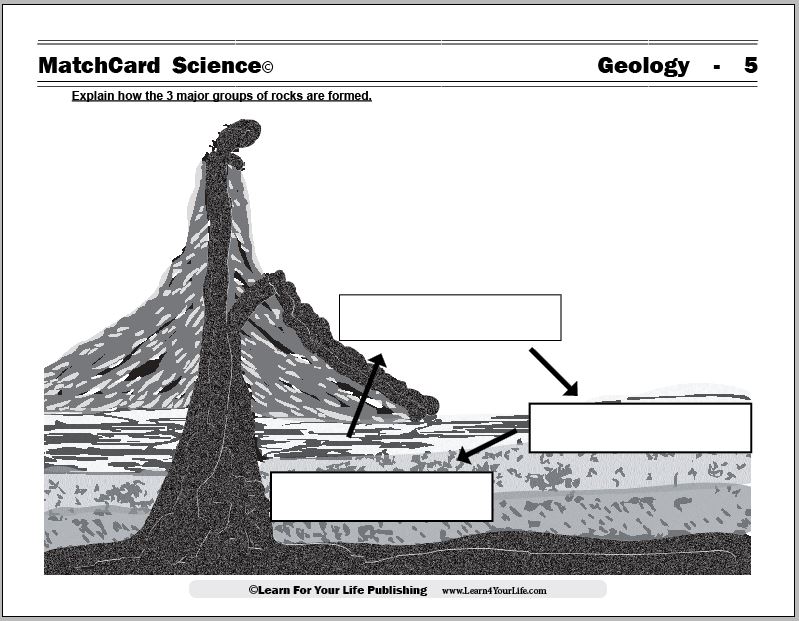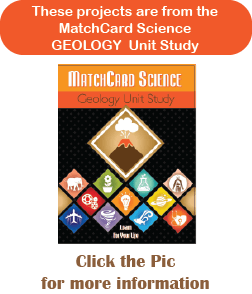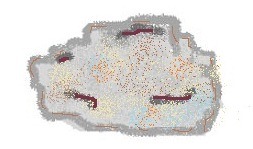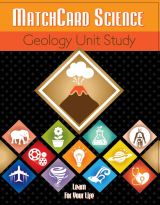Rock Cycle Worksheet
Three Types of Rocks: Igneous, Sedimentary, Metamorphic
The Rock Cycle Worksheet provides information and projects
for students in 3rd to 6th grade.
Free Download Below


MatchCard Science Rocks Cycle Worksheet
Objective: Explain how the three major types of rocks are formed.MatchCard: Download below.
MatchCard Information Pieces define and describe igneous, sedimentary, and metamorphic rocks, which can be used as a rock cycle worksheet. Ideas for projects are listed on the instructor's page and below.
Download and Use the Rock Cycle Worksheet
This is MatchCard #4 of the Geology Unit Study. Look below for more information on MatchCards and the MatchCard Science curriculum.Teaching the Rock Cycle

Igneous Rocks
What are igneous rocks?Igneous rocks are formed from the lava or magma of volcanos. When the volcanic material cools, it hardens into rock.
Igneous rocks are the starting point of all rocks, and are the most numerous on the Earth.
How can I tell if this rock is igneous?
Igenous rocks are usually porous, or have small pockets of air. Bread and styrofoam are also porous.
Tear off a small piece of bread or styrofoam and notice the pores.
Igneous Rocks have smaller pores. Other rocks may be porous as well, but the pore of igneous rocks usually are about the same size and distance apart.
Identify igneous rocks on the rock cycle worksheet.
The igneous rocks are identified by the line at the top, indicating they are formed from volcanic lava.
Memory Device: Igenous rocks were ignited by volcanoes.
Sedimentary Rocks
What are sedimentary rocks?The weathering process causes the formation of sedimentary rocks. As other rocks are broken into small pieces they are carried away by water. Sedimentation is the layering of different rocks and substances in water, such as a creek or river bed.
Different particles of different rocks and other substances become compressed. These other substances may be shells or fossils. The weight of the Earth's surface compresses these layered particles into sedimentary rock.
How can I tell if this rock is sedimentary?
If you have a large enough chunk of rock, one might see the different colored substances that made up the rock.
Look at the sedimentation process.
You may want to do the Rain Erosion project from the Weathering MatchCard to investigate how sedimentation occurs.
It is also interesting to take a field trip to large rock formations. Often you can see the layering of these rocks, even from a distance.
Identify sedimentary rocks on the rock cycle worksheet.
Identify sedimentary rocks as those closer to the top of the earth's surface, indicating that the weathering process causes their formation.
Metamorphic Rocks
What are metamorphic rocks?Metamorphic rocks are formed when other rocks are partially melted and remolded. This occurs deep under the Earth's surface where the temperature has increased.
Metamorphosis means change. We are often familiar with the metamorphosis of a caterpillar into a butterfly. Metamorphosis is the change of one type of rock to another through the process of heat and pressure as the rock is melted and re-molded.
How can I tell if this rock is igneous?
Some forms of metamorphic rock, such as marble, show the mixing and molding of more than one substance. Some metamorphic rocks are foliated, or banded, which shows the direction of the pressure applied during the rocks' formation.
Identify metamorphic rocks on the rock cycle worksheet.
The metamorphic rocks are identified as the line underground, which indicates they are formed below the Earth's surface. As geologic processes occur, these metamorphic rocks can become magma; and the cycle restarts.
Memory Device: Melting and Molding Morphs Metamorphic Rocks.
Collect Rocks
During your geology unit study, the student should collect specimens of rocks from your area. Let them try to identify which are igneous, sedimentary, or metamorphic.After trying to identify them, let them look in a rock field guide or on-line pictures of common rocks.
Is it hard to tell? Don't get discouraged. Remember, we are often looking at small fragments of rocks, which makes it much harder to identify it. Compare that to trying to identify a tree if you had only one small piece of the bark. An expert could do it, but it might be a challenge for a novice.
Emulate the Rock Cycle
Try this project to emulate the rock cycle.Supplies Needed
- Four different colored crayons
- A cheese grater
- A knife (does not need to be sharp)
- A hammer
- 2 plastic, re-sealable bags
- A heat source (microwave, heating pad, or even the sun.)
- Adult supervision is required for this activity.
- Use the cheese grater to shred fine pieces of one colored crayon.
- With the knife (or vegetable peeler) shave pieces off a second color.
- Shave similar pieces from a third colored crayon, but this time cut them even smaller with the scissors.
- Use a small hammer or other object (even a rock) to break the fourth crayon into small chunks.
Make Sedimentary Rocks
- Put cold water in a re-sealable plastic bag.
- Add the four different "igneous rocks" you made.
- Agitate and shake the bag to mix the particles. Them leave the bag alone as they settle down and layer.
- Puncture a small hole in the bag to let it drain of all water.
- Put the first bag in a second bag to prevent the crayons from seeping out.
- Now put the bags in the microwave for about 5 to 10 seconds. This just softens the crayons.
Let's Morph the Rock
Now we are going to change our sedimentary rock into a metamorphic rock.
Take the "rock" you made with crayons from the last activity.
- If you have a long, thin, "sedimentary rock," break it into two or three pieces.
- Put the pieces together in a stack. Then put it into the plastic bag that did not have a hole in it.
- Melt in the microwave for about 20 seconds. You can also place on the heating pad or in the hot sun for about five minutes.
- Now place the melted wax under a stack of heavy books.
- Leave it to cool.
Start the Cycle Over Again
To demonstrate that the rock cycle IS a cycle, have the students grate the metamorphic rock to start all over again.
Go Eat Rocks!
Here’s a yummy way to review the rock cycle: metamorphic fudge!Igneous
Melt & mix these ingredients to make igneous rocks:- 1 cup sugar
- 1 Tablespoon butter
- 1/3 cup evaporated milk
- 1 tsp vanilla
Sedimentary
Make a layer of sedimentary rocks by pressing together:- 3/4 cup crispie rice cereal or marshmallows
- 1 cup chocolate chips
- 1/2 cup chopped walnuts
Metamorphic
Let’s morph it all together. Fold the solid ingredients into the hot mixture. Can heat some more if needed. Pour onto waxed paper and continue folding the mixture onto itself. Let your rocks cool before eating them.In addition to the Rock Cycle Worksheet, MatchCard, and Projects; check out our other rock, mineral and geology activities in this unit study. >
MatchCard Science
How To Use MatchCards

Download the FREE MatchCard Science Instructor's Guide and see how MatchCards can make building their science knowledge base fun.
Geology Unit Study

12 Science Unit Studies

Chemistry is only one of twelve complete unit studies for kids in 3rd to 8th grade.
Comprehensive objectives, hands-on projects, suggested science fair experiments, and the fun game-like MatchCards keep them interested in learning science. See all twelve MatchCard Science Unit Studies.
About Our Site
Hands-On Learning














